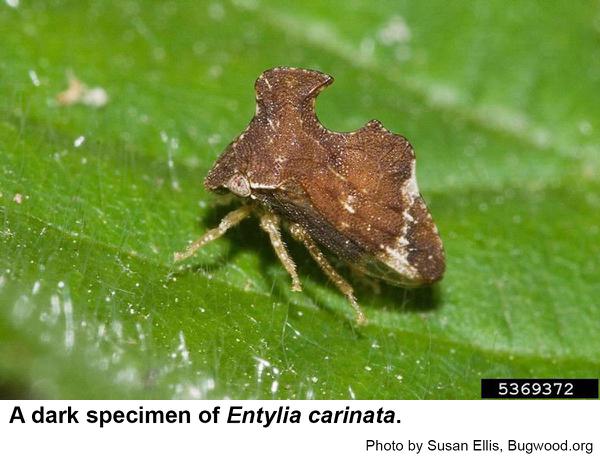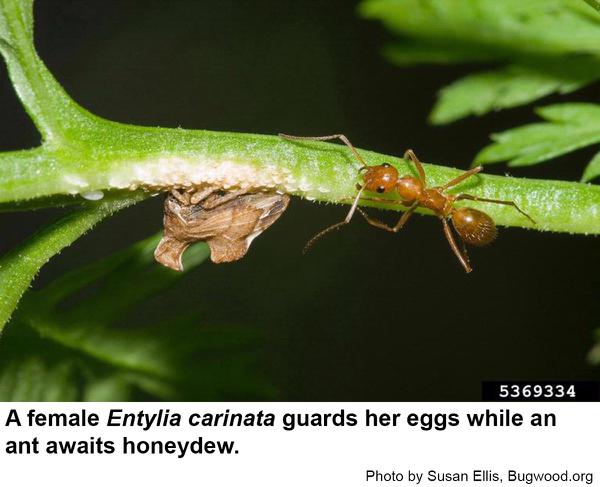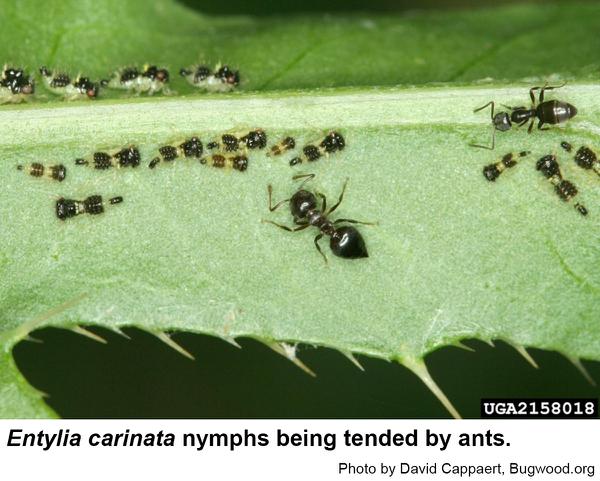Description and Biology
Keeled treehoppers, Entylia carinata, are small, brown, treehoppers with saddle-shaped keels. They are sometimes noticed on ornamental plants in the yard. Females are almost ¼ inch long and have extravagant protuberances on their thoraces. Males are slightly smaller, and their protuberances are less pronounced. (Males are so dissimilar from females that they have been described as different species!) Nymphs are smaller and have noticeable multiple pronged spines on top. Older nymphs develop their protuberances further with each molt. Keeled treehoppers overwinter as adults in leaf litter. They emerge in early spring (March) and embed their eggs in the midrib of tender golden rod leaves and many other plants. The leaf may fold at this point to form a shelter in which the nymphs develop. Keeled treehoppers mothers guard their egg masses in a tiny show of maternal (presocial) behavior. These treehoppers are often attended by ants that give these treehoppers protection from predators. The ants in turn feed on honeydew excreted by these treehoppers. Keeled treehoppers have been collected as late as December 19 in North Carolina. We have at least four generations per year of Entylia treehoppers here.
Host Plants
Keeled treehoppers tend to feed on composites including aster, baccharis, beggartick, boneset, dahlia, fireweed, fleabane, goldenrod, horseweed, joe-pie weed, ragweed, sunflower and yacon (Smallanthus sonchifolius). They have been found on dogwood, oak, solanum and yarrow as well.
Residential Recommendations
Keeled treehoppers do not transmit plant diseases and are more of a curiosity than plant pests. No pesticide recommendation seems necessary.
References
- Interactive keys to the genera and higher taxa of treehoppers (Hemiptera: Membracidae) of the United States: Part 1. Primer. Wallace, M. S. 2010. National Science Foundation, NCSU Insect Museum, and East Stroudsburg University of Pennsylvania.
- Keeled Treehopper, Entylia carinata. Anonymous. 2008. Nature Search, Fontenelle Forest.
-
New host record for Entylia carinata (Forster) (Hemiptera: Membracidae). Flynn, D. et al. 2018. Insecta Mundi. 0664: 1-4.
The Treehoppers of Missouri: Part 2. Subfamily Smiliinae; Tribes Acutalini, Ceresini, and Polyglyptini (Homoptera: Membracidae). Kopp, D. D. and T. R. Yonke. 1973. Journal of the Kansas Entomological Society Vol. 46 (2): 233-276.
- NC State Extension Plant Pathology Publications
- NC State Extension Horticultural Science Publications
- North Carolina Agricultural Chemicals Manual
For assistance with a specific problem, contact your local Cooperative Extension center.
This factsheet has not been peer reviewed.
Publication date: March 13, 2017
Reviewed/Revised: Dec. 21, 2021
N.C. Cooperative Extension prohibits discrimination and harassment regardless of age, color, disability, family and marital status, gender identity, national origin, political beliefs, race, religion, sex (including pregnancy), sexual orientation and veteran status.




